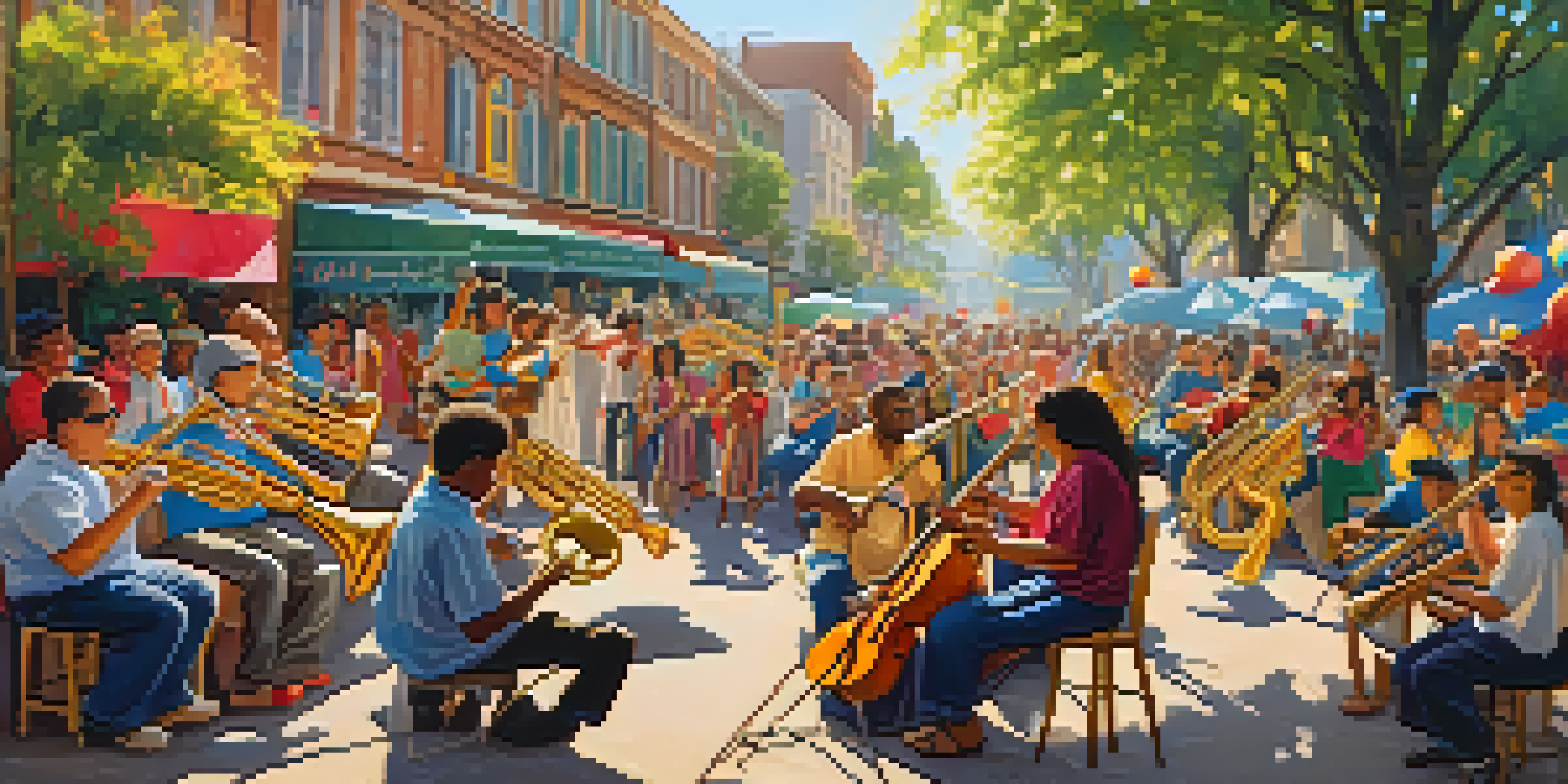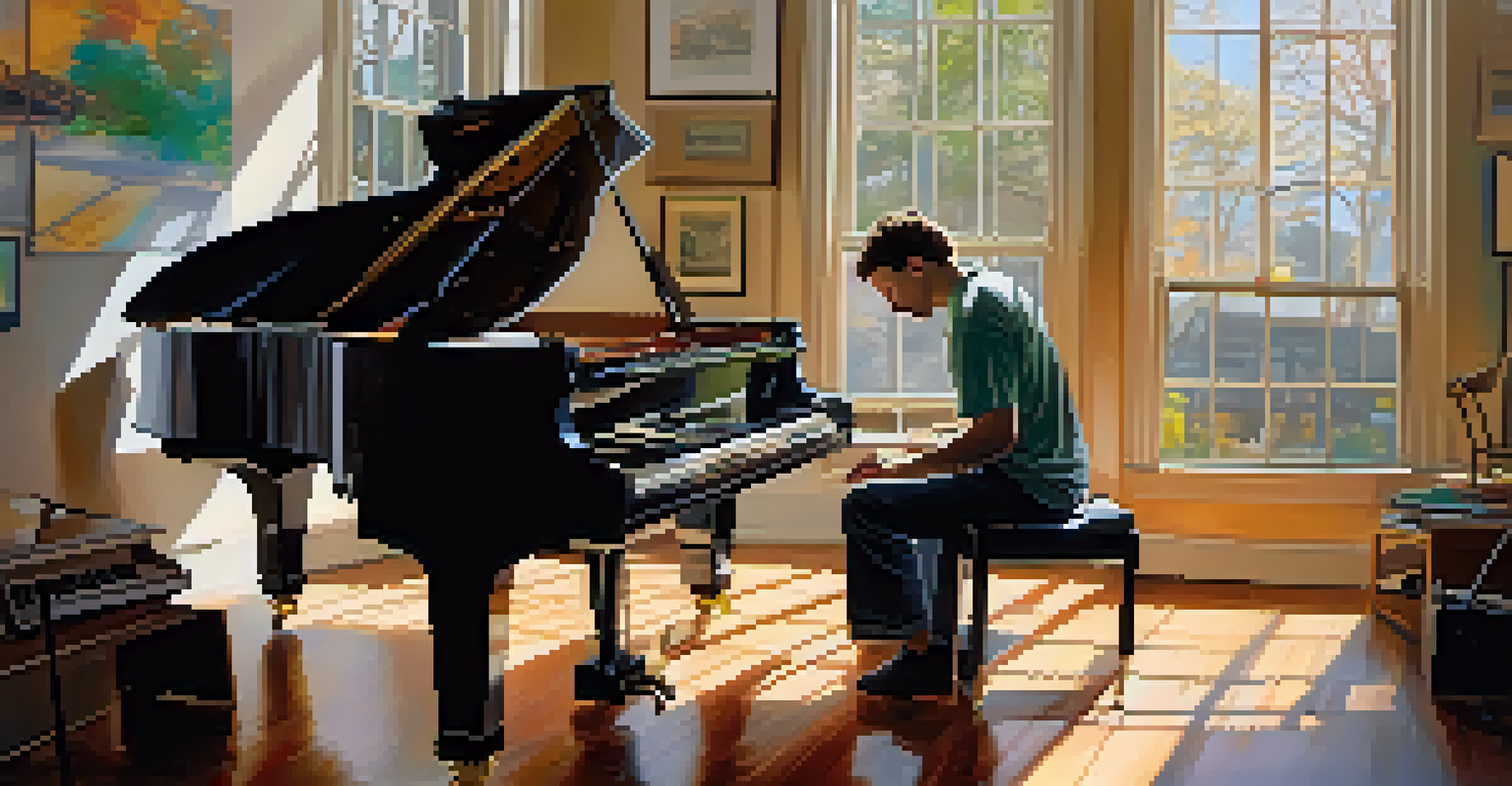Music and Disability: Identity and Representation in Art

Understanding Disability Through the Lens of Music
Music is a powerful medium that can express complex emotions and experiences, including those related to disability. It allows individuals to share their stories and challenges, fostering a deeper understanding of their realities. This exploration can lead to empathy and connection between people with disabilities and those without, bridging gaps in perception.
Music can change the world because it can change people.
As musicians with disabilities create art, they redefine what it means to live with a disability. Their work challenges stereotypes and showcases the richness of diverse experiences. By sharing their unique perspectives through music, they contribute to a broader narrative that celebrates individuality rather than focusing solely on limitations.
Moreover, music can serve as a form of empowerment for individuals with disabilities. It offers a platform to assert identity and resist societal stigma. When artists with disabilities are celebrated, it not only enriches the music landscape but also inspires others to embrace their identities fully.
Representation Matters: Visibility in the Music Industry
Representation in the music industry is crucial for fostering an inclusive environment. When artists with disabilities are visible, it sends a powerful message that diversity is valued. This visibility can encourage more musicians from varied backgrounds to share their stories, enriching the artistic landscape with different perspectives.

However, the music industry has historically underrepresented artists with disabilities. Many face barriers to entry, from accessibility issues in performance spaces to a lack of support from industry professionals. Addressing these challenges is essential for creating an equitable space where everyone can thrive.
Music Empowers Disabled Artists
Through music, artists with disabilities can express their identities, challenge stereotypes, and inspire others to embrace their uniqueness.
When representation improves, it not only benefits artists but also audiences. Listeners gain access to a wider range of experiences and stories, leading to greater understanding and appreciation of diversity. This shift can ultimately reshape societal attitudes towards disability, fostering a culture of inclusivity.
The Role of Music in Building Disability Identity
Music plays a significant role in shaping individual and collective identities, including those of people with disabilities. It allows artists to articulate their experiences in ways that resonate with others who share similar journeys. Through their work, they can foster a sense of community and belonging.
Art enables us to find ourselves and lose ourselves at the same time.
Moreover, music can serve as a tool for self-discovery and expression. For many artists with disabilities, creating music becomes a means of exploring their identity and experiences. This exploration can lead to personal growth and a stronger sense of self, empowering them to share their stories with the world.
As these artists share their narratives through music, they contribute to a larger dialogue about disability. Their voices challenge misconceptions and promote understanding, paving the way for a more inclusive society. In this way, music becomes a vehicle for both personal and collective identity formation.
Challenges Faced by Disabled Musicians
Disabled musicians often encounter various challenges that can hinder their artistic journey. These may include physical barriers to accessing venues, lack of financial support, or limited opportunities for exposure. Such obstacles can make it difficult for talented individuals to share their music with a wider audience.
Additionally, societal perceptions and stereotypes can also impact disabled musicians. Many may face discrimination based on preconceived notions about their abilities. This stigma can discourage artists from pursuing their passion, ultimately limiting the diversity of voices in the music industry.
Representation Enhances Inclusivity
Visibility of disabled musicians in the industry not only enriches the artistic landscape but also fosters understanding and appreciation of diverse experiences.
Despite these challenges, many disabled musicians persist and find innovative ways to overcome barriers. By leveraging technology, they can create and distribute their music independently. Their resilience not only enriches the music industry but also inspires others to challenge norms and pursue their dreams.
The Intersection of Music and Disability Advocacy
Music often intersects with disability advocacy, serving as a powerful tool for raising awareness. Artists leverage their platforms to highlight issues facing the disabled community, fostering dialogue and understanding. Through their music, they can address topics like accessibility, representation, and social justice.
Moreover, collaborations between musicians and advocacy groups can amplify these messages. By working together, they can create impactful campaigns that resonate with audiences. This partnership helps to raise awareness and drive change, ultimately benefiting the entire community.
The intersection of music and advocacy also cultivates a sense of solidarity among disabled individuals. It reinforces the idea that their voices matter and that they are not alone in their struggles. Music becomes a rallying cry for change, inspiring collective action and fostering a more inclusive society.
Highlighting Notable Disabled Musicians
There are many remarkable musicians with disabilities who have made significant contributions to the music world. Their talents and stories inspire countless others, proving that disability does not define one's ability to create impactful art. From classical composers to modern pop stars, these artists showcase the diverse talents within the disabled community.
For example, artists like Beethoven, who faced deafness, composed some of the most beloved symphonies despite his challenges. Similarly, contemporary musicians like Lizzo and Niall Horan have used their platforms to advocate for inclusivity and representation. Their journeys remind us that talent knows no bounds and that creativity can flourish in the face of adversity.
Challenges Hinder Artistic Expression
Disabled musicians face numerous obstacles, including societal stigma and accessibility issues, that can limit their opportunities to share their art.
Highlighting these musicians' stories not only celebrates their achievements but also encourages others to pursue their passions. By sharing their experiences, they inspire a new generation of artists with disabilities, fostering a culture of creativity and inclusion within the music industry.
Future Directions for Music and Disability Representation
The future of music and disability representation holds exciting potential. As conversations around inclusivity and diversity continue to grow, there is an increasing awareness of the importance of representation in all forms of art. This shift opens doors for more artists with disabilities to share their stories and be recognized for their contributions.
Advancements in technology also play a crucial role in this evolution. Digital platforms allow artists to reach wider audiences without the traditional barriers of the music industry. This democratization of music creation and distribution can empower disabled musicians to showcase their talents on their own terms.

Ultimately, the ongoing commitment to inclusivity and representation will shape the future of music. By embracing diversity, we can create a richer and more vibrant musical landscape that reflects the experiences of all individuals. The journey towards a more inclusive music industry is just beginning, and the possibilities are endless.